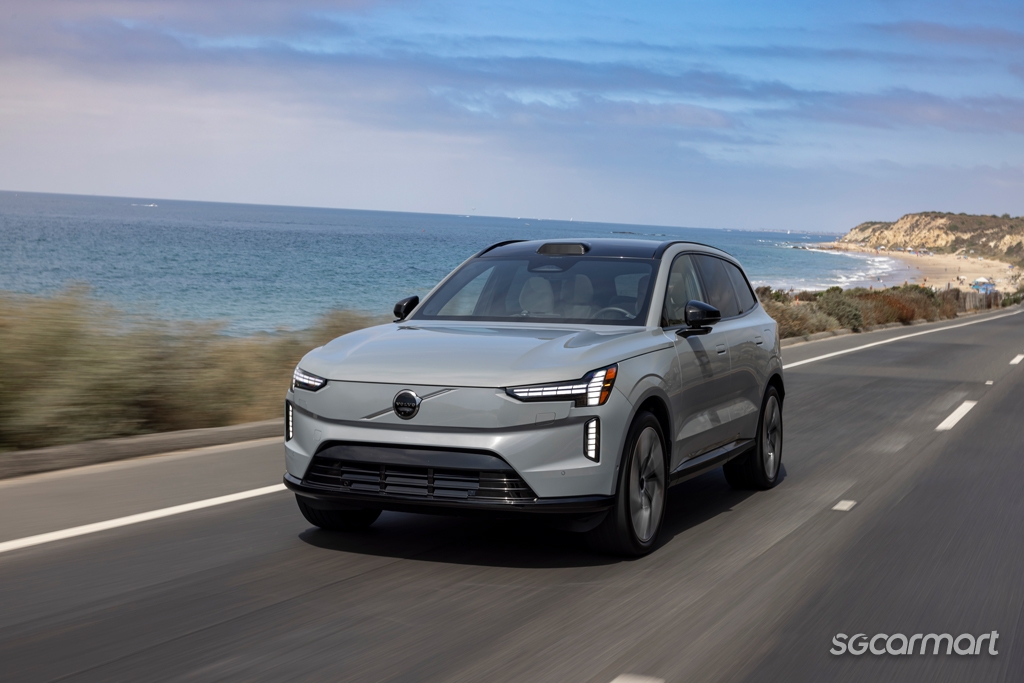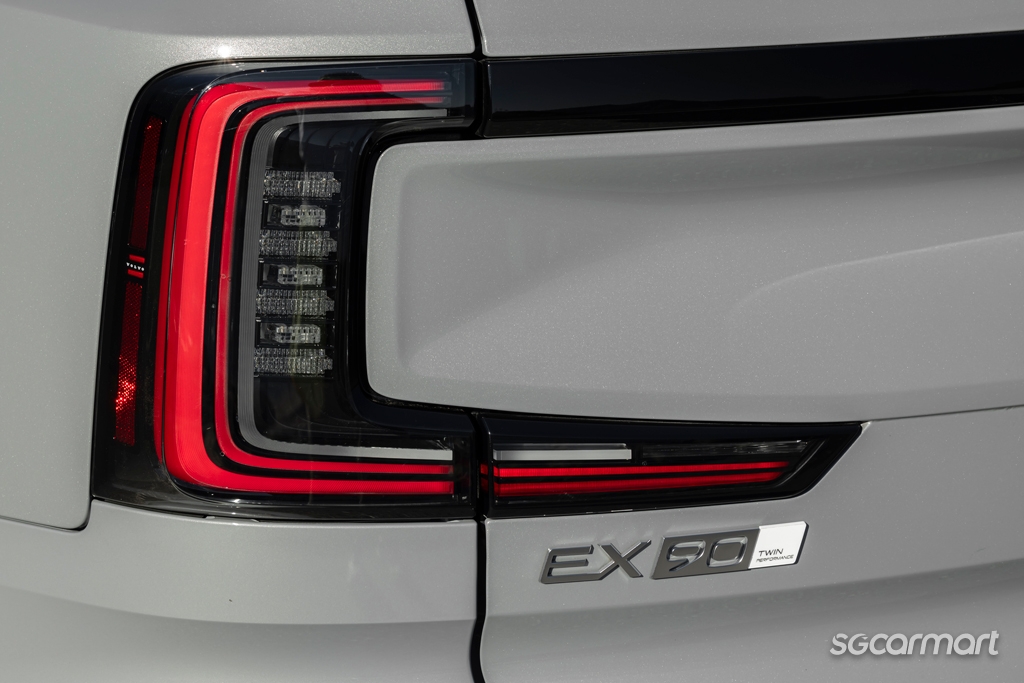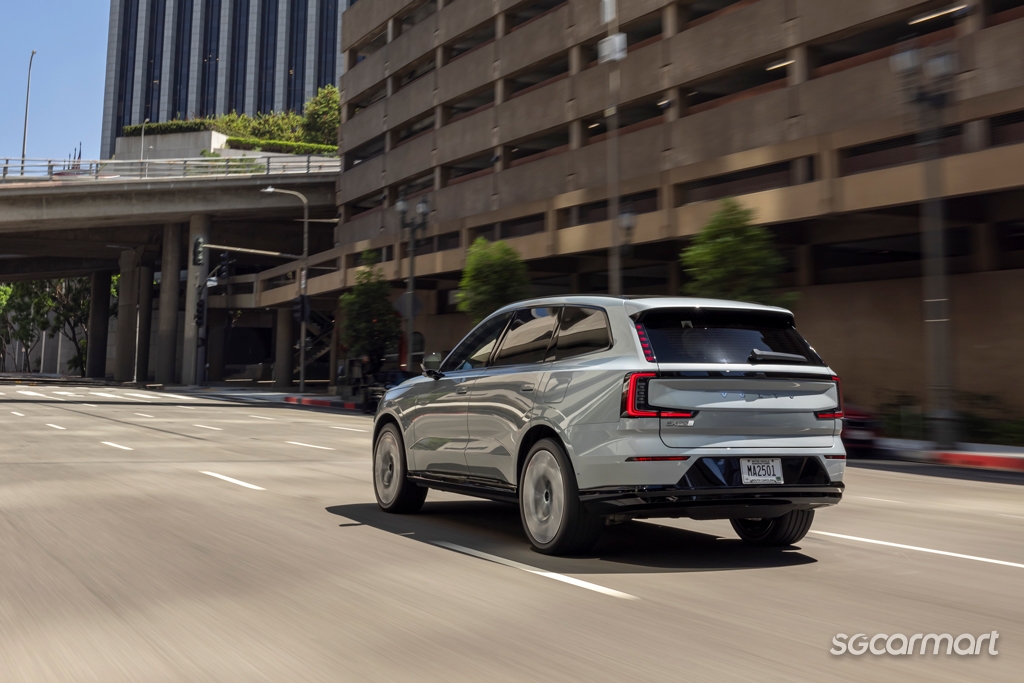Volvo EX90 Twin Motor Performance First Drive Review
11 Sep 2024|8,003 views
What We Like
Superb composure
Well-designed interior
Rapid performance
Pliant ride
Excellent audio system
What We Dislike
Not all functions work
UX issues - not enough buttons
Third-row still just for kids
If there's one thing that Volvo does well apart from safety, it is making cars that feel like tanks. This is especially true when it comes to their SUVs, with everything from the XC40 to the XC90 feeling like a bank vault on wheels.
That heftiness may be comforting to customers, but it also comes with an obvious downside: The weight makes the cars feel unwieldy. To be fair though, Volvo has not marketed these cars as 'sporty'.
That might change now that the EX90, which is also the most powerful Volvo to date, has arrived. Volvo aims to sell only electric vehicles by 2030, so naturally, there is a need for a flagship model. The real surprise, however, is that it does not feel like a traditional Volvo.
It's easy to mistake the EX90 for an XC90, but the blanked off grille makes it easy to tell them apart
You look kind of familiar...
The Swedish carmaker's design language is so strong that even if the EX90 was stripped of its badges, people would still recognise it as a Volvo. I asked Orjan Sterner, Senior Design Manager for the EX90's exterior, how this came about.
"A designer faces numerous challenges especially with regard to packaging the car and making the aesthetics work with the demands for engineering and safety. But the main challenge is to make a new model look fresh, yet still familiar." Indeed.
So, from afar, the EX90 resembles its internal combustion sibling, the recently updated XC90. Approach the EX90, however, and differences emerge. It has segmented (I refer to them as 'pixellated') and hammer-shaped daytime running lights, made to look longer by the vertical fog lights.
There's no grille, of course, and the Volvo badge has been given the minimalist treatment. Those typical strong shoulder lines, however, are as prominent as ever, giving the EX90 its muscular character. I'm not too sure about the C-shaped taillights, though. While not out of place, they make the rear look Polestar-inspired.
The clean cockpit will appeal to minimalists, but the lack of physical switches has its downsides, too
Dive into a new world
If you haven't driven a new Volvo lately, prepare to be immersed in the brand's current aesthetic, which is a blend of sustainable, high-tech and minimalist philosophies. It also has an unmistakable Scandinavian feel.
Access to the car is via a Phone Key or a digital key stored in your smartphone - the EX90 is the first Volvo to be so-equipped. A key card is also provided, but you'll need to place it at a specific spot on the charging pad to switch on the car.
The only physical buttons inside are on the steering wheel. Fortunately, they are hybrid units that are both mechanical and capacitive touch. Yes, lightly resting your thumbs on them brings up menu options, but you can also press them and enjoy real tactility.
The menus aren't deep, and the climate controls are always at the bottom of the display for convenience
Few buttons mean the functions are inside the infotainment system. There is a learning curve here, but to Volvo's credit, they have designed the interface to be 'shallow'.
There's a tile menu that's relatively intuitive and clicking on an option brings you to a second page, but it doesn't go deeper than that, so newbie users can return to the homepage if they feel overwhelmed. Shortcuts to the home screen and climate controls are permanently at the bottom for easier access, too.
But Volvo perhaps has taken a step too far in its quest for simplicity. While it is true that most Volvo buyers won't bother with driving modes or the possibility of adjusting parameters, burying these options means you can't adjust the steering weight and damping level on the fly.
Catering to occupants' well-being are the excellent seats, which continue to strike a balance between supportiveness and cushiness. And for listening pleasure, the EX90 is the first Volvo equipped with Dolby Atmos via its Bowers & Wilkins audio system.
You're better off in the second row than in the third one, but crucially, occupants in the latter still get full-size seats and headrests
Passengers in the EX90's second row benefit from a flat floor and three individual seats, which enhances comfort. Each outer passenger gets their own B-pillar air-con vent, while the middle passenger can have the two on the centre console all to themselves.
The third-row accommodations are okay only if you are below 1.75 metres tall. More legroom can be had by asking the people in front to move their seats forward (thus reducing their space), but at least there are C-pillar vents to help you stay cool. Still, it's best to think of the EX90 as a flexible 5+2 rather than a proper seven-seater SUV.
Calm progress
The EX90 is Volvo's most refined model to date, and it's clear that the manufacturer has spent considerable effort to deliver a hushed cabin and pliant ride, the latter courtesy of the standard two-chamber air suspension.
At the same time, this Twin Motor Performance is also Volvo's most powerful model to date, with the electric motors pushing out 510bhp (380kW) and a monumental 910Nm of torque. With traction from the all-wheel drive system and clever torque vectoring, this 2.5-tonne SUV finishes the century sprint in 4.9 seconds.
Volvo says that the electric motors utilised by the EX90 are the first to be designed and produced in-house, leading to better integration with the rest of the powertrain. The 111kWh battery, which is sourced from CATL, provides a maximum combined driving range of 614km (WLTP).
The EX90's mass means its quick turn of speed is blunted - you don't get pinned to the seat when you nail the accelerator pedal. Instead, this SUV is remarkably composed - it will take a lot to ruffle its feathers.
There's no 'Sport' setting, but put your foot down and 510bhp and 910Nm of torque are yours to command
A good part of our driving route was up and down Ortega Highway in the hills above Newport Beach in California. It's a winding road with numerous corners that range from gentle to tight. Who said American roads were all straight and boring?
Here, the EX90 was in its element. For a large and hefty SUV, its steering is surprisingly accurate and its chassis keen to follow the driver's inputs. You'd think it would feel elephantine, but it's not.
In fact, the EX90 was surprisingly good at flowing through corners. 'Flow' is not a word you'd have used to describe older Volvos, but you would here. I never imagined piloting a big Volvo SUV with such ease and performance, that it could take corners quicker than expected.
More importantly, it's got plenty of composure, too. Rutted and pockmarked surfaces? The air suspension dismisses these with ease. Coupled with those excellent seats, road trips should be a breeze.
The big hiccup here, though, is the user experience (UX). Without paddle shifters that let you control the regeneration level of the brakes, you must dig through the menu to tweak it when you're at the lights.
Adjusting the steering and damper settings is not a problem, but this is an issue by itself. On the one hand, switching to the firmer/sportier setting barely does anything to either characteristic. Also, the EX90's lane-keeping function doesn't work well if the road markings are faded.
Pluses and misses
Volvo has done a lot right with the EX90. It features Volvo's distinct design language, comes with the 'Scandi' interior fans love, and has more technology than we can understand in a half a day of driving.
But not everything works as intended, as I heard some journalists had issues with the Phone Key, while wireless Apple CarPlay will only be available via an over-the-air update. For an otherwise polished product, misses like these become glaring pain points.
UX issues aside, the EX90 is a refreshing product. Fans of older Volvos may not like it but exchanging the tank-like feel for better performance, driveability and comfort is the way to go. It does not feel like a 'traditional' Volvo, but that might be the right step for the brand.
These stories may also interest you
High-tech and with the looks to match, the EV9 shows that Kia has what it takes to do battle with premium brands in an electric age
The EQS SUV, with its sheer presence, silky ride and numerous refinements, might be the swankiest electric Mercedes to date
What We Like
Superb composure
Well-designed interior
Rapid performance
Pliant ride
Excellent audio system
What We Dislike
Not all functions work
UX issues - not enough buttons
Third-row still just for kids
If there's one thing that Volvo does well apart from safety, it is making cars that feel like tanks. This is especially true when it comes to their SUVs, with everything from the XC40 to the XC90 feeling like a bank vault on wheels.
That heftiness may be comforting to customers, but it also comes with an obvious downside: The weight makes the cars feel unwieldy. To be fair though, Volvo has not marketed these cars as 'sporty'.
That might change now that the EX90, which is also the most powerful Volvo to date, has arrived. Volvo aims to sell only electric vehicles by 2030, so naturally, there is a need for a flagship model. The real surprise, however, is that it does not feel like a traditional Volvo.
It's easy to mistake the EX90 for an XC90, but the blanked off grille makes it easy to tell them apart
You look kind of familiar...
The Swedish carmaker's design language is so strong that even if the EX90 was stripped of its badges, people would still recognise it as a Volvo. I asked Orjan Sterner, Senior Design Manager for the EX90's exterior, how this came about.
"A designer faces numerous challenges especially with regard to packaging the car and making the aesthetics work with the demands for engineering and safety. But the main challenge is to make a new model look fresh, yet still familiar." Indeed.
So, from afar, the EX90 resembles its internal combustion sibling, the recently updated XC90. Approach the EX90, however, and differences emerge. It has segmented (I refer to them as 'pixellated') and hammer-shaped daytime running lights, made to look longer by the vertical fog lights.
There's no grille, of course, and the Volvo badge has been given the minimalist treatment. Those typical strong shoulder lines, however, are as prominent as ever, giving the EX90 its muscular character. I'm not too sure about the C-shaped taillights, though. While not out of place, they make the rear look Polestar-inspired.
The clean cockpit will appeal to minimalists, but the lack of physical switches has its downsides, too
Dive into a new world
If you haven't driven a new Volvo lately, prepare to be immersed in the brand's current aesthetic, which is a blend of sustainable, high-tech and minimalist philosophies. It also has an unmistakable Scandinavian feel.
Access to the car is via a Phone Key or a digital key stored in your smartphone - the EX90 is the first Volvo to be so-equipped. A key card is also provided, but you'll need to place it at a specific spot on the charging pad to switch on the car.
The only physical buttons inside are on the steering wheel. Fortunately, they are hybrid units that are both mechanical and capacitive touch. Yes, lightly resting your thumbs on them brings up menu options, but you can also press them and enjoy real tactility.
The menus aren't deep, and the climate controls are always at the bottom of the display for convenience
Few buttons mean the functions are inside the infotainment system. There is a learning curve here, but to Volvo's credit, they have designed the interface to be 'shallow'.
There's a tile menu that's relatively intuitive and clicking on an option brings you to a second page, but it doesn't go deeper than that, so newbie users can return to the homepage if they feel overwhelmed. Shortcuts to the home screen and climate controls are permanently at the bottom for easier access, too.
But Volvo perhaps has taken a step too far in its quest for simplicity. While it is true that most Volvo buyers won't bother with driving modes or the possibility of adjusting parameters, burying these options means you can't adjust the steering weight and damping level on the fly.
Catering to occupants' well-being are the excellent seats, which continue to strike a balance between supportiveness and cushiness. And for listening pleasure, the EX90 is the first Volvo equipped with Dolby Atmos via its Bowers & Wilkins audio system.
You're better off in the second row than in the third one, but crucially, occupants in the latter still get full-size seats and headrests
Passengers in the EX90's second row benefit from a flat floor and three individual seats, which enhances comfort. Each outer passenger gets their own B-pillar air-con vent, while the middle passenger can have the two on the centre console all to themselves.
The third-row accommodations are okay only if you are below 1.75 metres tall. More legroom can be had by asking the people in front to move their seats forward (thus reducing their space), but at least there are C-pillar vents to help you stay cool. Still, it's best to think of the EX90 as a flexible 5+2 rather than a proper seven-seater SUV.
Calm progress
The EX90 is Volvo's most refined model to date, and it's clear that the manufacturer has spent considerable effort to deliver a hushed cabin and pliant ride, the latter courtesy of the standard two-chamber air suspension.
At the same time, this Twin Motor Performance is also Volvo's most powerful model to date, with the electric motors pushing out 510bhp (380kW) and a monumental 910Nm of torque. With traction from the all-wheel drive system and clever torque vectoring, this 2.5-tonne SUV finishes the century sprint in 4.9 seconds.
Volvo says that the electric motors utilised by the EX90 are the first to be designed and produced in-house, leading to better integration with the rest of the powertrain. The 111kWh battery, which is sourced from CATL, provides a maximum combined driving range of 614km (WLTP).
The EX90's mass means its quick turn of speed is blunted - you don't get pinned to the seat when you nail the accelerator pedal. Instead, this SUV is remarkably composed - it will take a lot to ruffle its feathers.
There's no 'Sport' setting, but put your foot down and 510bhp and 910Nm of torque are yours to command
A good part of our driving route was up and down Ortega Highway in the hills above Newport Beach in California. It's a winding road with numerous corners that range from gentle to tight. Who said American roads were all straight and boring?
Here, the EX90 was in its element. For a large and hefty SUV, its steering is surprisingly accurate and its chassis keen to follow the driver's inputs. You'd think it would feel elephantine, but it's not.
In fact, the EX90 was surprisingly good at flowing through corners. 'Flow' is not a word you'd have used to describe older Volvos, but you would here. I never imagined piloting a big Volvo SUV with such ease and performance, that it could take corners quicker than expected.
More importantly, it's got plenty of composure, too. Rutted and pockmarked surfaces? The air suspension dismisses these with ease. Coupled with those excellent seats, road trips should be a breeze.
The big hiccup here, though, is the user experience (UX). Without paddle shifters that let you control the regeneration level of the brakes, you must dig through the menu to tweak it when you're at the lights.
Adjusting the steering and damper settings is not a problem, but this is an issue by itself. On the one hand, switching to the firmer/sportier setting barely does anything to either characteristic. Also, the EX90's lane-keeping function doesn't work well if the road markings are faded.
Pluses and misses
Volvo has done a lot right with the EX90. It features Volvo's distinct design language, comes with the 'Scandi' interior fans love, and has more technology than we can understand in a half a day of driving.
But not everything works as intended, as I heard some journalists had issues with the Phone Key, while wireless Apple CarPlay will only be available via an over-the-air update. For an otherwise polished product, misses like these become glaring pain points.
UX issues aside, the EX90 is a refreshing product. Fans of older Volvos may not like it but exchanging the tank-like feel for better performance, driveability and comfort is the way to go. It does not feel like a 'traditional' Volvo, but that might be the right step for the brand.
These stories may also interest you
High-tech and with the looks to match, the EV9 shows that Kia has what it takes to do battle with premium brands in an electric age
The EQS SUV, with its sheer presence, silky ride and numerous refinements, might be the swankiest electric Mercedes to date
Thank You For Your Subscription.
- You Look Kind Of Familiar...
- Dive Into A New World
- Calm Progress
- Pluses And Misses





































































